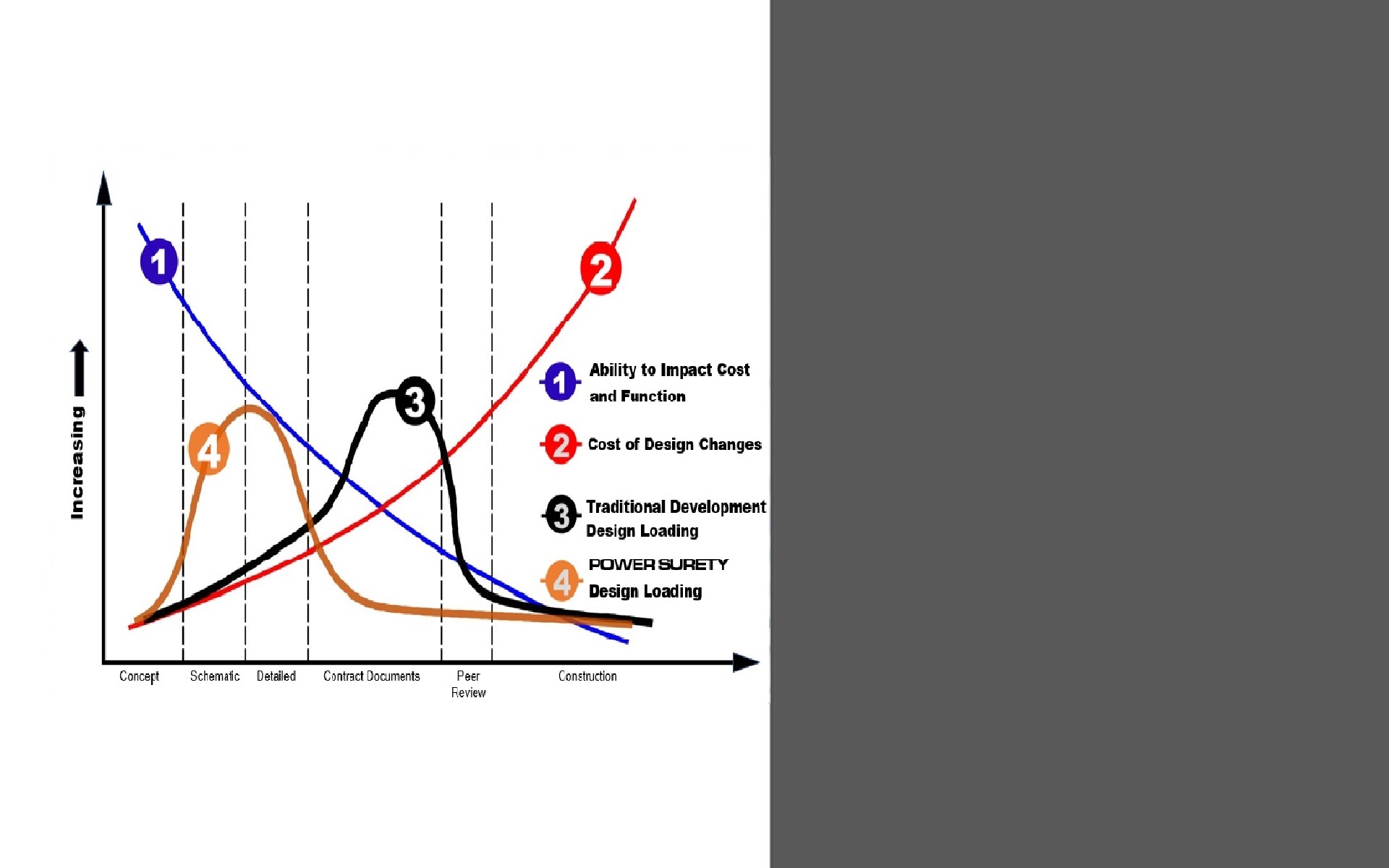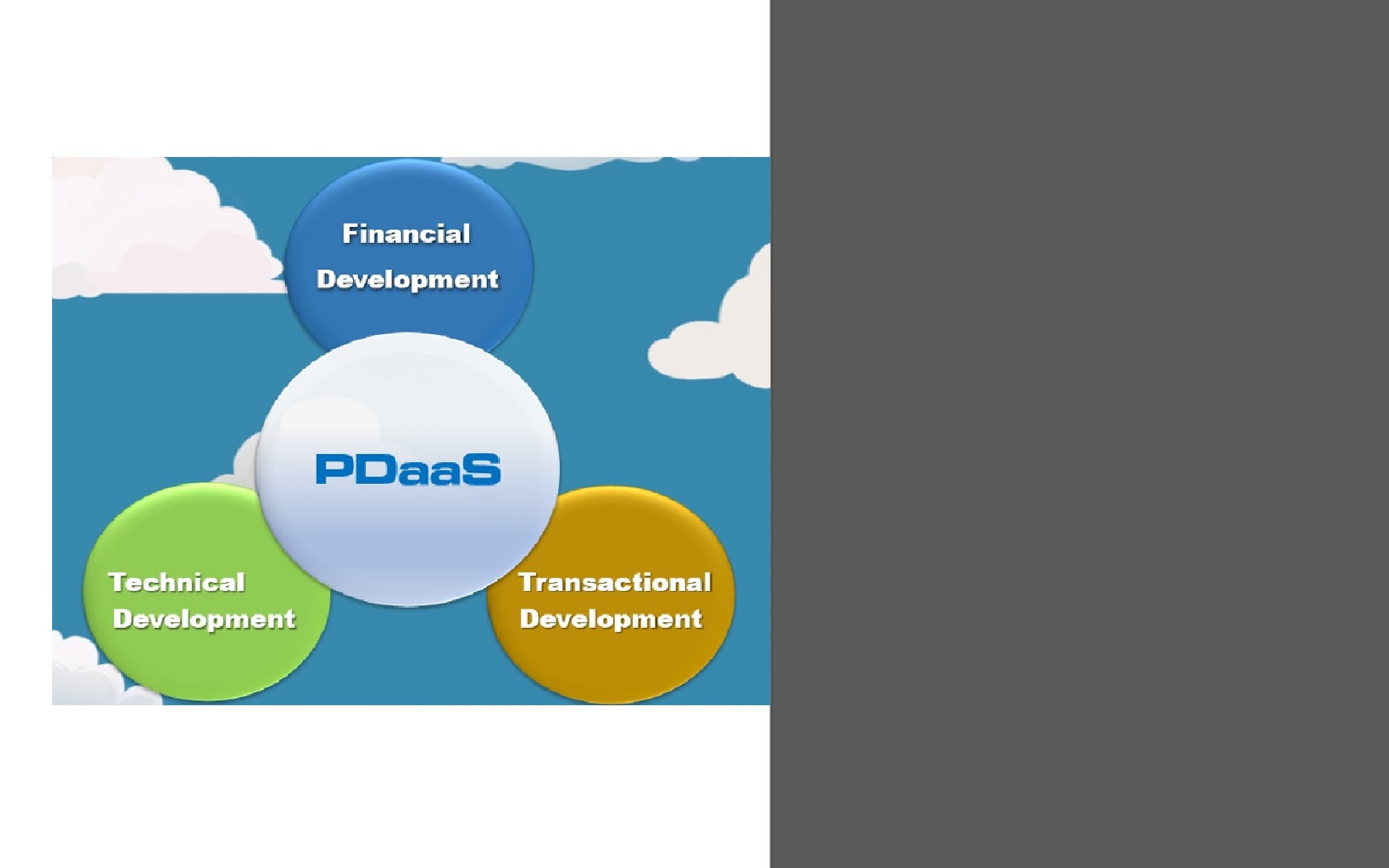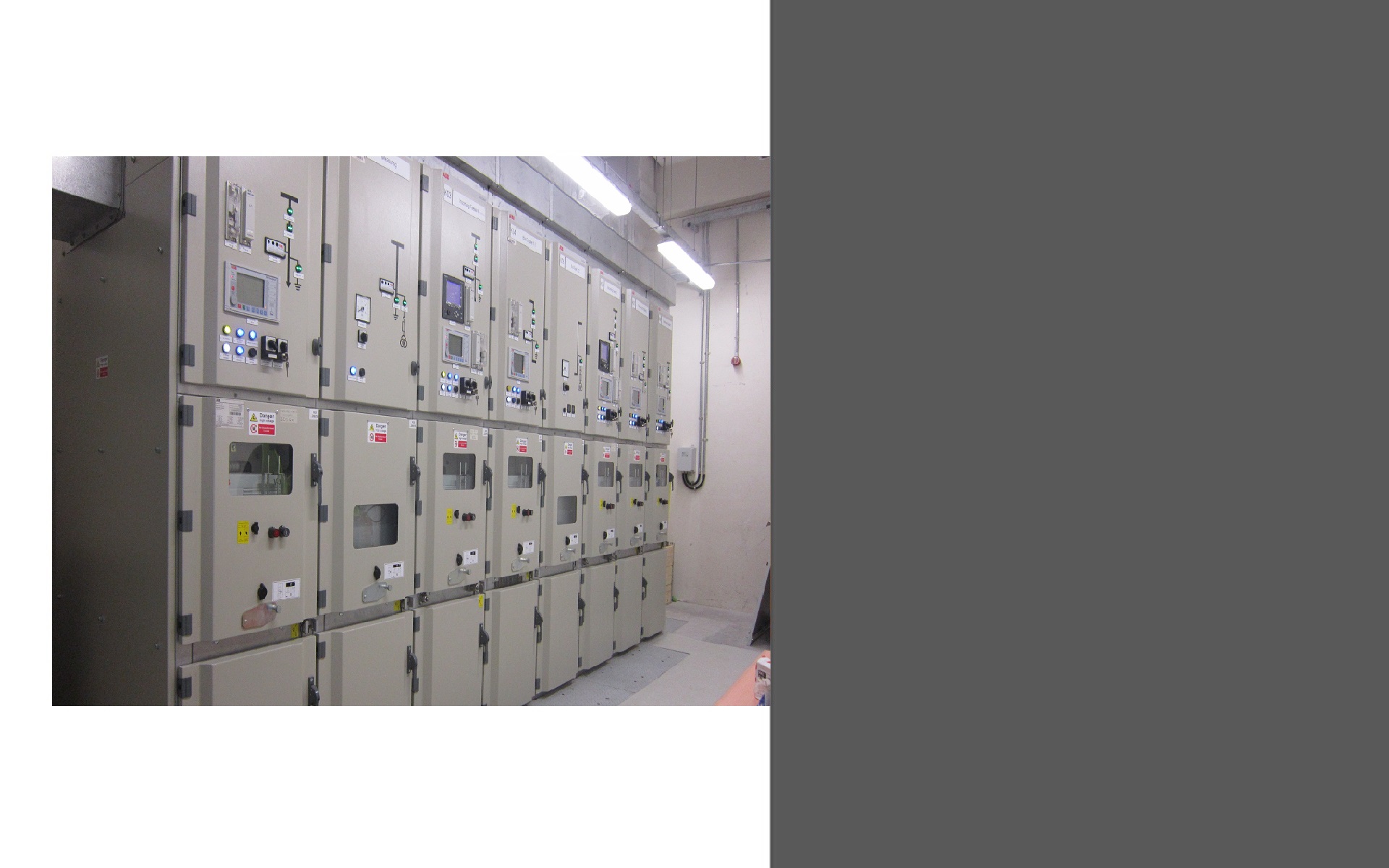Integrated Project Delivery
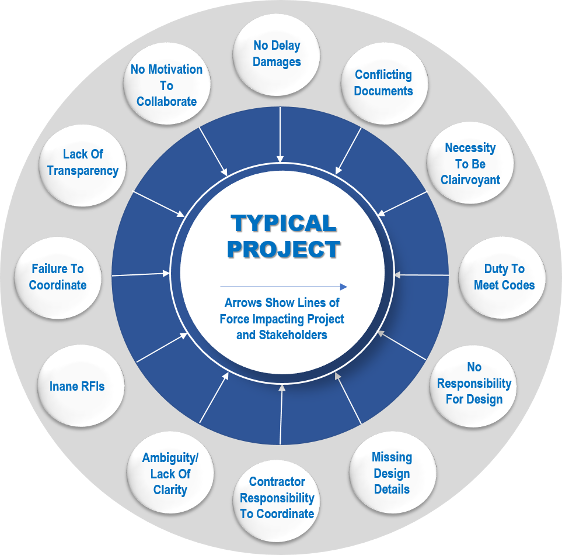
Typical Project Delivery – “Disconnected” Project Teams:
Any major project involves development and delivery risk. However, energy projects are especially risky because they have the potential to disrupt essential services. Traditional project delivery models can create inefficiencies, thus increasing pressure on desired economic viabilities and functional performance.
Despite decades of attempts to improve traditional delivery approaches, (design-bid-award, design-build, construction manager at risk) projects are still frequently over-budget and delivered late. Oftentimes, completed energy projects developed and delivered with conventional approaches do not perform to expectations and requirements solidified during early stages of the project.
Some of the most significant drivers for change from typical approaches are:
1) Perceived inefficiencies in the current delivery model
2) Renewed scrutiny on costs and budgets
3) Desire for increased transparency
4) Lack of trust
5) Too much conflict
6) Frustrations with defensive behavior and finger pointing
7) Desire to improve communication and collaboration
Conventional project delivery processes often lead to finger-pointing between owners, prime contractors, subcontractors, and designers, leading to “repulsive” rather than “attractive” stakeholder relationships and team dynamics.
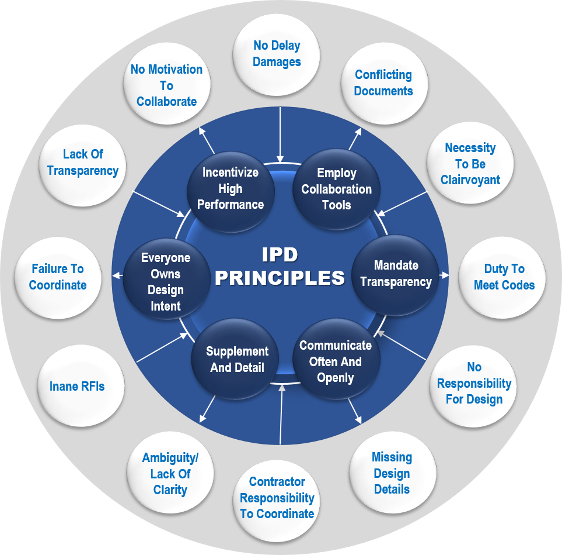
Integrated Project Delivery – “Coordinated” Project Teams:
IPD projects are characterized by the high level of stakeholder collaboration that takes place during the development and delivery of a project using widely communicated and transparently available technical and financial deliverables.
IPD project teams strive to eliminate waste and share risk and rewards among key project stakeholders through integrated forms of agreement and processes. IPD back feeds or front loads tasks such as measurement and verification (M&V), commissioning, and operational processes into the design and construction of the project. This ensures that subject matter experts necessary in later stages of delivery have a voice and a “seat at the table” during the formative stages of development.
By transparently making this information available early-on in project development, all project stakeholders can truly have the potential to “sing from the same sheet of music” throughout the project lifecycle, thereby avoiding disconnects between development perceptions and operational realities. This enables project teams that are “attractive” in their form and nature rather than “repulsive” in their form and nature.

Design Collaboration and Integration:
IPD processes employed during early project development improve design qualities by engaging a larger talent pool during the critical coordination and programming stages of project development.
Subject matter expertise pertaining to many elements of an energy project’s design do not exist solely within the domain of architects and engineers contracted with design responsibilities. Facility operators, building managers, public works control technicians, staff accountants, subcontractors, and equipment vendors alike can enhance project outcomes provided they are given the right information and are involved in the development process.
Developing competent deliverables that clearly communicate design basis details early-on in project development, and distributing those details widely, is key to the kind of project stakeholder integration that imparts diversified subject matter intelligence into your project.
Ultimately, this imparting of diversified subject matter expertise and intelligence, reduces risk, improves project outcomes, and preserves long-term reputations by firmly connecting development expectations to operational realities.

Stakeholder Engagement and Collaboration:
Power Surety utilizes web-based project collaboration tools to enable and encourage open and honest communication and transparency throughout the project. This enables an “open-book” approach to all technical and financial matters that ultimately determine project success. Integrated stakeholders work seamlessly with designers and constructors on important decisions to leverage their knowledge bases and encourage joint accountability.
PowerSurety staff work with prime contractors and project owners to bring all key project participants into the process earlier and in collaboration with each other to create a more efficient work environment. Allowing stakeholders to join a project earlier in the process, rather than waiting until designs and documents have been completed, improves efficiencies and outcomes. This element of IPD is especially valuable, as the ability to have an impact on a project is significantly diminished as the project progresses.
Therefore, bringing diverse and differing parties to the table to offer their opinions during early-stage development allows them to have an actual effect and positive impact on the project. The reverse of this approach would be for these parties to start construction with completed designs that have been handed to them with no previous input or involvement on their parts. Diverse input catches mistakes and errors early-on and typically results in fewer change orders down the line.
If you have interest in understanding more about how IPD tenets and practices might improve the level of stakeholder integration and effectiveness on your projects, please contact us.
Early Project Deliverables
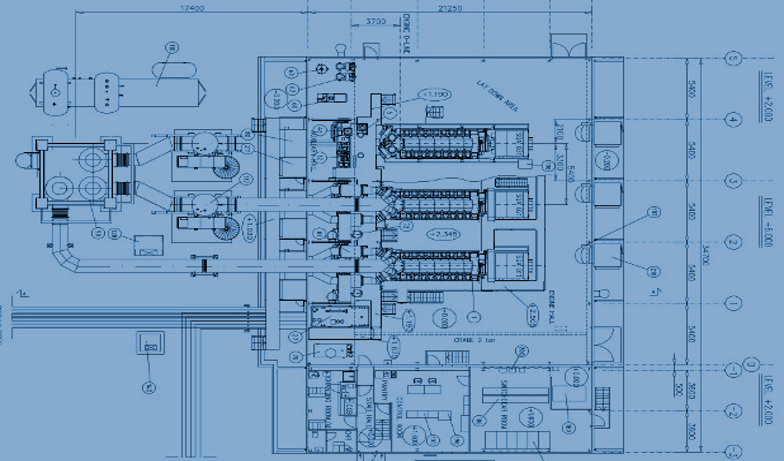
Providing formal design documents early in the design process improves collaboration and development efficiencies. The prevailing “wisdom” on many energy projects early in the development phase is to defer the incurrence of “at-risk” engineering expense until a contract for construction is more assured. The problem with this approach is that much of the project’s design basis is established during this early timeframe, creating situations where critical elements of the project’s scope will be based largely on loosely available information from stakeholder groups who have vested interests that can easily change after contract award.
Without clear documentation of scope details, including drawings and specifications, not only can scope disputes arise at a later date, but holding subcontractors to cost estimates becomes nearly impossible. Additionally, the less scope and schedule detail provided to a trades subcontractor, the more contingency will be included in the estimate. The issue of wringing-out unnecessary project costs was perhaps less acute when fast-payback energy efficiency projects were more plentiful. But with white-hot focus from owners now being placed on energy resiliency, microgrids, energy storage, and power quality and reliability, it is imperative that all unnecessary direct costs be squeezed from projects. This can only be effectively accomplished at the trades subcontractor level through a transparent competitive selection process. Unfortunately, the type of competition that produces lowest-cost pricing can only be achieved with competent bidding documents that are clear and unambiguous.
PowerSurety provides engineered plans and specifications for projects we are involved with as early in the development process as possible. We design exclusively in 3-D and typically prepare designs through the schematic design level (35%), which is sufficient to perform material take-offs for engineering estimates. A typical schematic design set will include the following:
1) Outline Equipment Specifications
2) Single-line Electricals
3) Electrical and Mechanical General Arrangements including Major Distribution Runs
4) Preliminary Site Plan
5) Preliminary Demo Plan
6) Equipment Schedules
7) Basis of Design Narrative
8) Control System Block Diagram / Philosophy / Network Map
This level of design is necessary to provide project stakeholders the right information from which to collaborate on the project and make informed decisions.

Early-stage understanding of energy project lifecycle costs is critical to shaping project capital expenses (CAPEX) and operational expenses (OPEX) during the development phase in lieu of cutting corners on construction or short-changing operational budgets. Economic lifespans of energy projects can exceed 30 years, necessitating the need to fully understand these long-term costs and their variabilities, both of which impact ROI’s and profit margins.
PowerSurety staff have been providing solutions to the Design-Build-Operate marketplace for the last 20 years and we can assist energy service companies, developers, utilities, and end-users in taking into account, all long-term costs associated with acquiring, owning, and disposing of energy infrastructure systems.
Non-fuel operating costs and operations, maintenance, repair, and replacement (OMR&R) costs are typically more difficult to estimate than initial construction expenditures. The variability that exists between operating schedules and standards of maintenance vary from project to project and there is always uncertainty in future costs for the repair and replacement of material and equipment as the project ages.
Power Surety takes these uncertainties into account and performs a probabilistic analysis to help quantify these variables to help improve future budget certainty.
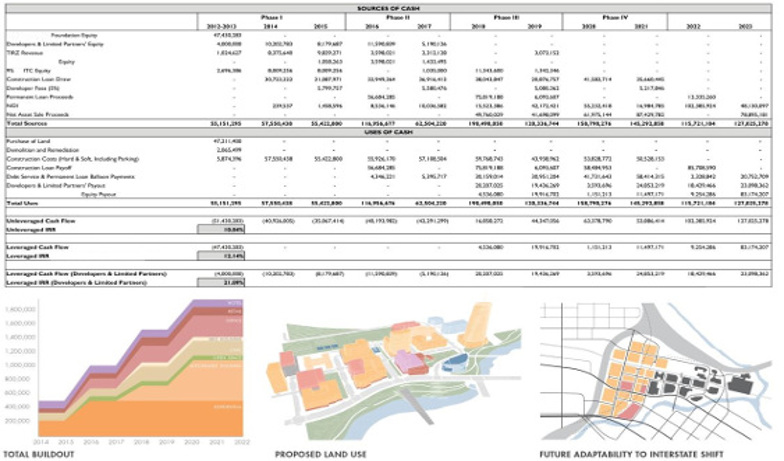
The combination of the below deliverables is what Power Surety calls a “2% Guaranteed Maximum Price (GMP) Package”:
– Project Initial Development
– IPD Stakeholder Collaboration
– Programming and Concept Design
– ROM Pricing and Feasibility
– Schematic Designs and Specifications
– Sufficient to support quantity takeoffs
– Sufficient to support competitive market pricing
– Prepare bid comparisons (BidComps) for critical systems and equipment
– Early Permitting and Interconnect Activities
– Prepare GMP Engineering, Procurement and Construction (EPC) Costs
– Prepare Operational Proformas
– Based on market pricing, cost estimates and forecasts for the life of the project
The “2%” relates to the typical cost for this package as it relates to the total construction price of the project. As an example, a $2.5 million microgrid project would roughly equate to a cost of $50,000 for this level of design information.
The 2% package provides the necessary information to positively understand costs, schedules and project returns; enables an IPD platform to integrate stakeholders into the early development efforts; provides an early-start for lengthy permitting and interconnect processes; and sets up fast-track project development and delivery schedules moving forward.
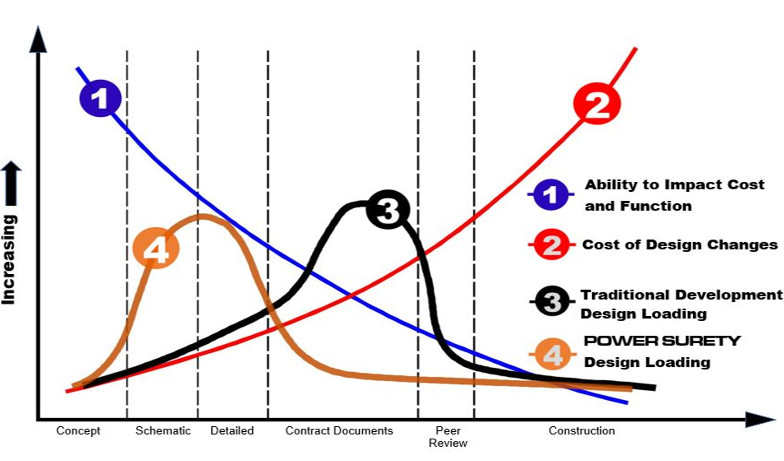
The opportunity to save time and money is created by “integration” of the “design” function early in the development life cycle. The very nature of the responsibilities a designer faces within a traditional project delivery scheme are fundamentally different than those that come with being a part of an integrated team during development. In the latter case, the designer receives helpful value engineering input from a variety of functional experts, including manufacturers, subcontractors, and facility operators, early in the design process. Under traditional project delivery approaches, the designer typically works in somewhat of a vacuum and may not receive design-changing input until bids are received back from contractors
This functional integration of design into early development changes the very nature of the “design” task itself. This fact is best demonstrated through the Cost Influence Curve developed by Stanford Professor Boyd Paulson in 1978. Paulson’s Cost Influence Curve describes the dwindling ability to influence project cost results as the project moves out of the planning and design phases and into the construction phase.
To see greater details on PowerSurety’s early deliverables approach, click the button here:
Public-Private Partnership

Enabled by Congress with the passage of the Energy Policy Act of 1992, and codified as 42 U.S.C. 8256, over $3 billion have been invested in Utility Energy Services Contracts (UESCs) since 2000. Moreover, 2,000+ projects, ranging from smaller energy efficiency projects to large, comprehensive demand management and onsite generation projects, have been implemented through the UESC program. There are currently more than 65 utilities participating the U.S. Department of Energy-managed UESC program.
A primary benefit of UESCs is their flexibility since the blending of paid-from-savings and appropriated funding is allowable under the program. PowerSurety principals were early UESC pioneers, have over 50 years of combined experience working under the program, have collaborated with over 25 utility UESC providers, and have developed, financed, and implemented scores of UESC projects.
If you could use support launching or managing a UESC program or project, please contact us and we’ll be happy to explore how we might be able to help.

Also enabled by Congress with the passage of the Energy Policy Act of 1992 and codified by 42 USC 8287, nearly $6 billion have been invested in Energy Savings Performance Contracts (ESPC) by U.S. federal agencies with cumulative savings of over $12 billion having been realized.
In 2015, the U.S. Army Corps of Engineers (USACE) issued their third-generation ESPC Indefinite Delivery/Indefinite Quantity (IDIQ) multiple award task order contract (MATOC) to 14 energy service contractors. The aggregate contract ceiling for all 14 contractors under the USACE MATOC is $1.5 billion.
In 2017, the U.S. Department of Energy (DOE) issued their third-generation multiple award Indefinite Delivery/Indefinite Quantity (IDIQ) ESPCs. Contracts were issued to a total of 21 energy service companies (ESCOs) who had previously been previously qualified as viable contractors. The aggregate contract ceiling for all 21 contractors under the DOE IDIQ is $55 billion.
“This program highlights how the public and private sector partnerships can align with the Administration’s objectives for increased energy efficiency and job creation without burdensome regulations,” said U.S. Secretary of Energy Rick Perry. “A key component is that these energy and water efficiency projects at federal facilities pay for themselves, and the hope is that all federal agencies will utilize this financing method to the fullest extent.”
PowerSurety seeks to assist ESCOs by providing a wide variety of consulting and support services for their ESPC programs and projects. Our principals are expert in all aspects of ESPC and offer a broad menu of services and support. Please contact us to learn more.

Public-Private Partnerships (P3) are contractual relationships between a public agency and a private sector entity. The public agency can be federal, state, or local, and the private party can be virtually any form of legal entity. Public-Public-Private Partnerships (P4) are contractual relationships between two public agencies and a private sector entity. P4 transactions are becoming much more common and oftentimes involve a state or federal agency working with a local municipality or county government, and both agencies working with a private entity.
A good example of a P4 is a critical load renewable energy microgrid project developed and implemented by Chevron USA’s energy services division at the Marine Corps Logistics Base (MCLB) in Albany, Georgia. In this case, the project was developed under the U.S. Department of Energy’s (DOE) Energy Savings Performance Contracting (ESPC) program with two federal agencies, DOE and the U.S. Department of Defense, and Dougherty County, Georgia.
In order to provide renewable fuel to a new onsite cogeneration system that served mission critical loads, Dougherty County entered into a methane off-take agreement with MCLB. Instead of flaring excess landfill-derived methane as they’d previously been doing, Dougherty County elected to reduce their greenhouse gas emissions by capturing and diverting the methane for a beneficial purpose that also served to create a new revenue stream for the County.
The benefits of the project were numerous: MCLB improved their level of energy resilience, funded their microgrid project with the cost savings it generated, and reduced their greenhouse gas footprint by reducing their volume of purchased electricity. Dougherty County created a new revenue stream and assisted one of its key constituents in implementing a mission critical project; and the world benefitted from a significant greenhouse gas reduction project. This P4 project surely created 4x benefit for the partnership.
The principals of PowerSurety have been deeply involved in developing, financing, implementing, and operating of P3- and P4-based energy infrastructure projects for over two decades and have a collective base of experience of over 65 years in structuring these types of projects.
With the advent of community microgrid projects and the intense focus public entities of all types have to reduce energy usage, improve energy resiliency, and reduce costs, P3s are rapidly becoming a preferred transactional structure due to their overall effectiveness and the high degree of flexibility they provide.
If you would like to learn more about Public-Private Partnerships or could use support with the transactional structuring or technical development of a P3 or P4 initiative, please connect with us and we’ll get to work for you.
Project Development as a Service (PDaaS)

If you are unfamiliar with the concept, “as a Service” models originated in the Information Technology (IT) industry as a means to reduce or eliminate the upfront costs of building data centers and buying the IT hardware and software that runs within them.
Various permutations of these “as a Service” models exist in the IT world. These structures allow different users to vary the level of commitment each make with respect to having company resources tied-up in IT functions. To many, the primary benefit of this approach is the ability it provides companies to focus headcount on core business functions rather than allocating it to utility-like IT functions.
These “as-a-Service” models are an efficient way to enable end-users to make use of the latest and most technically competent software, hardware, and infrastructure without actually buying it. With “as a Service” used for products and infrastructure, the end-use company enjoys the benefit of increased working capital since what would otherwise be a large upfront investment, is converted to a manageable operating expense.
Flexible “as a Service” lease terms that match end-users’ sales-cycles and business needs are provided along with service platforms that further enhance the creation of value-added advanced services. These services oftentimes come at considerably lower cost as compared to “business as usual” practices. A well-targeted suite of “as a Service” offerings resemble “apps” to the end-user for core business functions and services that are provided only when needed, and in on-demand fashion.
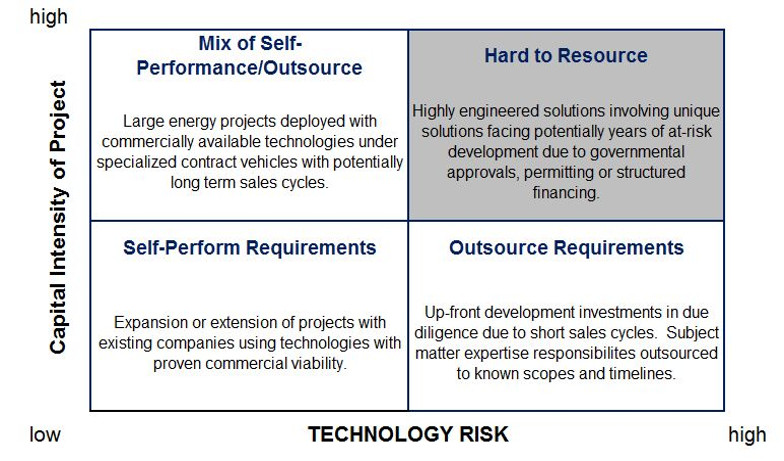
Energy infrastructure projects in general, and the energy services industry in particular, require service providers to deal with sales cycle-time uncertainty. Unique solutions, lack of familiarity with contract vehicles, complex financings, and lengthy review processes can all inject variability and significant delays into development schedules.
Project developers and energy service providers typically resource their projects based on a number of factors, but two are often weighted more than the others: 1) Complexity of the project, and 2) Capital intensity of the project, i.e. how many at-risk, pre-contract dollars will need to be spent?
The chart to the left summarizes some of the general characteristics of these projects in quadrant form, with increasing levels of technology risk shown on the horizontal axis and increasing levels of development capital requirements on the vertical axis.
The quadrant in the upper right corner of this chart describes the types of projects that present the greatest resourcing challenges to developers and energy service providers. These project types require highly engineered approaches that involve unique solutions. Oftentimes, these types of projects require years of at-risk development due to stakeholder misalignment, facility/agency politics or turf battles, multiple levels of governmental approvals, permitting, and structured financing.
In addition to the above factors, significant scrutiny of project cash flows due to the larger scope and scale of more complex projects, along with questions about the viability of certain technologies, can result in sales cycle-times that often become measured in years. These types of projects also require significant at-risk development cost to be expended in order to keep the project moving through the sales funnel. During extended project development cycles, maintaining continuity of resources to maintain project momentum can also be challenging.
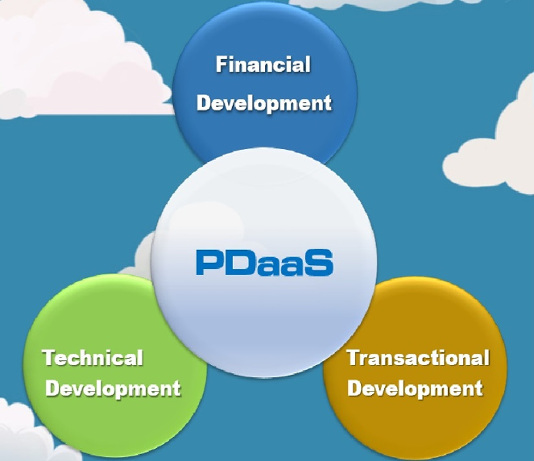
PowerSurety provides Project Development as a Service (PDaaS) to help developers and energy services companies mitigate the endemic sales cycle-time problem that exists by providing on-demand resources who are expert in providing the broad range of technical, contractual, and project finance services that complicated projects require. Having been involved in the development of over $2 billion in a wide variety of complex energy infrastructure projects, PowerSurety’s principals have a unique understanding of what’s required to mitigate risk and shorten sales cycles on large projects.
Even though sales cycle-times were discussed as challenges under the “Development Resourcing Challenges” tab of this section, PDaaS does not involve the outsourcing of Sales or Business Development resources. PDaaS simply provides a structure, competent resources, and a technical development approach that seeks to document requirements at the earliest moment possible, and to then iterate economic variables around established requirements – also as early as possible. Validating early-stage requirements (including schedule) and economics with senior decision-makers, enables Sales/Business Development staff to communicate and gain broad agreement and validation of key items such as project timing, desired outcomes, operational requirements, key performance indicators, etc.
Energy Surety Assessments
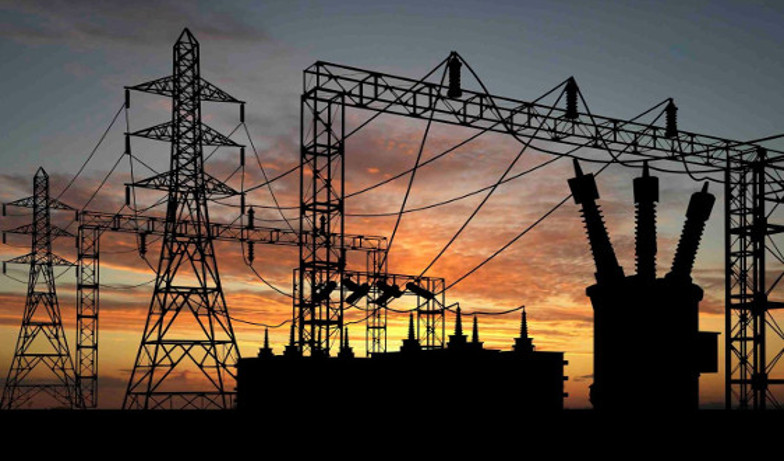
Energy resiliency and power quality requirements are unique to individual connected loads, oftentimes on a circuit-level basis. Characterizing these requirements; aggregating by circuit, building, facility, and distribution grid; and then defining the macro-interaction with the utility grid is a fundamental first-step in each and every microgrid assessment. It also provides foundational and necessary design criteria on which to base further analysis.
As an example, determining whether the desired level of grid interaction is more in line with a Department of Energy (DOE) or a Department of Defense (DoD) microgrid definition is a good starting point for the assessment effort.
Department of Energy (DoE) Microgrid Exchange Group:
“A microgrid is a group of interconnected loads and distributed energy resources within clearly defined electrical boundaries that acts as a single controllable entity with respect to the grid. A microgrid can connect and disconnect from the grid to enable it to operate in both grid-connected and island-mode.”
Department of Defense (DoD):
“A DoD installation microgrid is an integrated energy system consisting of interconnected loads and energy resources which, as an integrated system, can island from the local utility grid and function as a stand-alone system.”

Equal in importance to establishing quantitative baseline resiliency criteria is establishing a firm understanding of baseline energy usage patterns and costs.
Typical goals of many energy surety and microgrid initiatives are to obtain the following:
1) Increased reliability at a lower overall energy cost
2) Greater energy efficiency that leads to reduced costs
3) The ability to generate revenue by participating in ancillary services programs
4) Lowering overall cost by utilizing onsite generation assets as demand reduction resources
5) Optimizing the use of new/existing renewable generation assets to lower overall energy cost
Since energy cost is one of the key drivers for virtually all resiliency initiatives, PowerSurety’s early assessment efforts focus on defining historical and current patterns of energy use and determining actual costs incurred by analyzing utility bills, tariff structures, and interval data consumption.

Establishing baseline power quality and reliability conditions is critical to understanding the return on investment (ROI) of any microgrid or resiliency effort as it moves forward. PowerSurety staff work with clients and utility representatives to determine historical reliability patterns, and as necessary, supplement the work effort with additional data acquired by temporary data-logging and metering equipment. The energy resiliency services provided during this phase consists of reviewing and augmenting existing electrical distribution design documents and utility interconnection information to reflect current as-built conditions.
Obtaining historical metering information relevant to power quality and reliability for both the supply and distribution of electrical power on the existing sub-transmission and/or distribution systems is critical. Additional data logging can be performed to establish definitive power quality criteria and obtain information necessary for future microgrid stability model analyses.
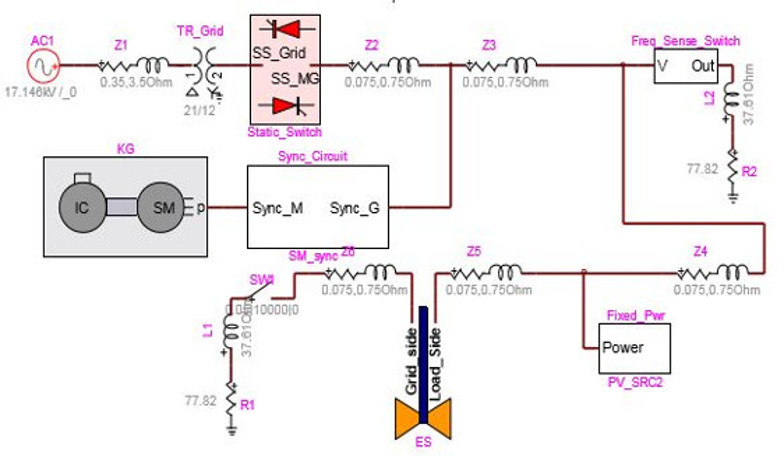
At the core of energy resiliency services provided during many assessments is the generation and iterative development of multiple microgrid topologies that can consist of varying distributed generation and storage assets in varying load scenarios. The objective of these simulations is to consider and produce viable system configurations for all possible combinations of matched loads and supplies. The models are dependent on and built using design criteria and requirements that were defined at the beginning of the assessment process. These simulations often evaluate hundreds or even thousands of system configurations and model operational results for each microgrid over an entire year’s time, and in intervals typically ranging from one minute to one hour.
These possible combinations of system types and operation are then sorted and prioritized using variables such as operating requirements, performance characteristics, and desired outcomes that were established early in the assessment process. The variables can be economics-driven (levelized cost of electricity), resiliency-based, (islanding time) reliability-centric, (power quality) or a blend of all three.

Based on the optimized microgrid topology that yields the desired resiliency and power quality results, economic models and sensitivity analyses are performed to determine levelized costs of energy from the proposed solution. Rough order of magnitude (ROM) notional capital and operating expense (CAPEX/OPEX) forecasts are developed based on takeoffs from concept microgrid designs. These costs are then rolled into operational proformas associated with the proposed system.
Additional microgrid benefits are then identified, quantified, and included in the economic analysis. These economic, operational, environmental, and public health and safety benefits can include the following:
- Reduced cost in expanding/maintaining energy generation or distribution capacity to accommodate future growth.
- Increased system reliability resulting from reduced exposure to utility-derived power outages on critical loads.
- Improved power quality as the result of significant reductions in the frequency of voltage sags and swells or in the quantity of momentary power interruptions to load centers.
- Reduced air pollution and greenhouse gas emission levels.
- Reduced damages, expense, or lost profits resulting from prolonged power outages.
- Enhanced public safety resulting from fewer prolonged power outages at facilities such as hospitals, police dispatch/communications centers, and community centers.
If you have interest in better understanding how PowerSurety can assist you with energy resiliency services in realizing the above benefits, please contact us.
Structured Project Finance
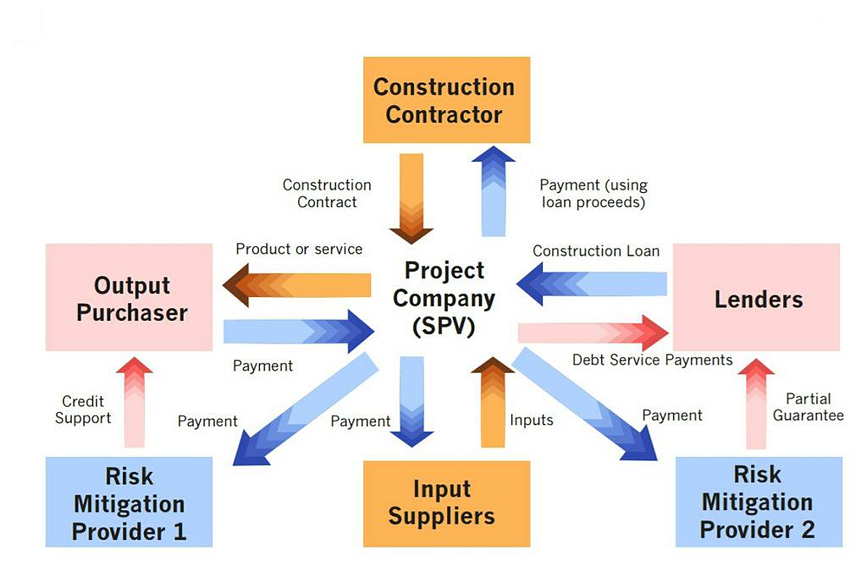
Structuring and financing transactions is an important element of implementing energy projects, particularly if the project beneficiary wants to avoid putting debt on their balance sheet. The technical project evaluation phase also provides the time needed to evaluate and discuss potential financing mechanisms for the envisioned project. The debt payments (or service payments) can be arranged in a variety of ways, and timed to the receipt of the energy savings, appropriations, or tax receipts. To ensure the lowest possible rate, our experience supports using financing RFPs to secure the most competitive rates.
Power Surety staff have been involved in the development of commercially viable projects and structured financings for over $2 billion worth of energy infrastructure projects. We have the skills necessary to understand unique owner requirements and then organize commercial terms and financing structures around those specific needs and factors.
Our staff are experienced across a wide spectrum of project types: K-12, Colleges/Universities, Municipalities, Public Housing Authorities, Non-Profit Organizations, Commercial Businesses and the Federal Government, with each segment having its own unique financing requirements. We have built relationships with a number of leading energy project financiers so that we can match the capabilities and transaction appetite of the financier with the needs of our client.
Our relationships include banks, leasing companies, investment bankers, and securitization conduits with these firms possessing special strengths and serve specific markets. Most are members of the Association for Governmental Leasing and Finance (AGLF) and the Equipment Leasing Association of America (ELA).
Municipal Adviser Disclaimer:
PowerSurety-Inc., or its affiliates and subsidiaries, are not registered with the Securities and Exchange Commission as “municipal advisors” as that term is defined in Section 975 of the Dodd-Frank Wall Street Reform and Consumer Protection Act amendment to Section 15B of the Securities Exchange Act of 1934 and therefore may not provide recommendations for specific needs, objectives, or circumstances of a municipal entity with respect to municipal financial products or the issuance of municipal securities, including with respect to the structure, timing, terms, and other similar matters concerning such financial products or issues.
Utility Independent Engineering

PowerSurety principals have met with program managers at well-known federal agencies to better understand the types of successes and challenges they are experiencing under their Utility Energy Services Contracting (UESC) and Energy Savings Performance Contracting (ESPC) programs. The managers we’ve met with have been quite candid with their feedback and shared frustration about the disparities they are seeing between the two programs.
They’ve told us that energy service companies (ESCOs) they work with appear to operate two separate development/delivery teams; one for ESPC and another for UESC. According to the agencies’ representatives, their ESPC projects appear to receive support from the ESCOs’ “A” teams, while their UESC projects seemed to receive support from their “B” teams. The government also voiced concern about differing ESCO approaches between the two programs, stating that energy usage baseline development for UESCs is being performed in a less disciplined and thorough manner under UESCs than under ESPCs.
From the government’s perspective, such an approach is not right and does a disservice to the UESC program, participating utilities, federal agencies, and U.S. taxpayers alike. Although frustrated with the current situation, the agency did have thoughts on how the situation could be substantially improved.
One was for utilities to engage independent third-party entities who are expert in both ESPC and UESC, to provide their programs with technical support, project-level due diligence, and program guidance as required. In the government’s view, UESCs are not part of a utility’s core mission, and as such, it is not reasonable to expect that utilities be expert in UESC or its nuances and associated risks in order to sponsor a program and participate. What is expected is that utilities engage others to assist the in managing the program and becoming expert in the development and delivery of projects.
Given the deep level of ESPC and UESC expertise possessed by PowerSurety principals and our belief that project development methodologies under both programs should be well aligned, we offer a specialized form of “Utility Independent Engineering” to our utility customers who engage in UESC program development and delivery. Not only do our services ensure that UESC projects are developed in a manner acceptable to all government agencies, we mitigate risk for our utility customers and provide a higher level of assurance that their UESC customers will be fully satisfied with the performance of the project for many years after acceptance.
PowerSurety develops projects using a process known as Integrated Project Delivery (IPD). IPD is a collaborative process that aligns stakeholder requirements and expectations and facilitates transparency and open communication among project participants. As such, PowerSurety’s focus is facilitating a smooth and seamless process whereby expectations are determined and agreed upon as early as possible in a project’s development cycle. Our process is not adversarial in nature, but intentionally collaborative and trust-building since anything less will slow progress and impede positive results.
Lastly, given PowerSurety’s expertise in energy resiliency projects and the government’s near universal desire to improve its levels of energy resiliency, PowerSurety can also provide guidance and input to assist utilities and their ESCO partners in developing economically viable, financeable, and operationally sound resiliency projects to be implemented through the UESC program.
If you have interest in discussing PowerSurety’s approach to UESC Independent Engineering and project facilitation services, please contact us to learn more.
PowerSurety PDaaS….continued
Providing formal design documents early in the design process improves collaboration and development efficiencies. The prevailing “wisdom” on many energy projects early in the development phase is to defer the incurrence of “at-risk” engineering expense until a contract for construction is more assured. The problem with this approach is that much of the project’s design basis is established during this early timeframe, creating situations where critical elements of the project’s scope will be based largely on loosely available information from stakeholder groups who have vested interests that can easily change after contract award.
Without clear documentation of scope details, including drawings and specifications, not only can scope disputes arise at a later date, but holding subcontractors to cost estimates becomes nearly impossible. Additionally, the less scope and schedule detail provided to a trades subcontractor, the more contingency will be included in the estimate.
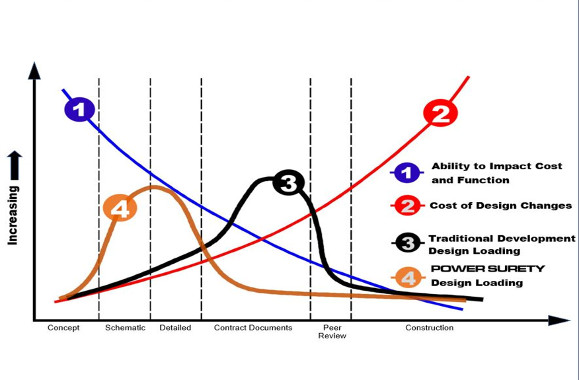
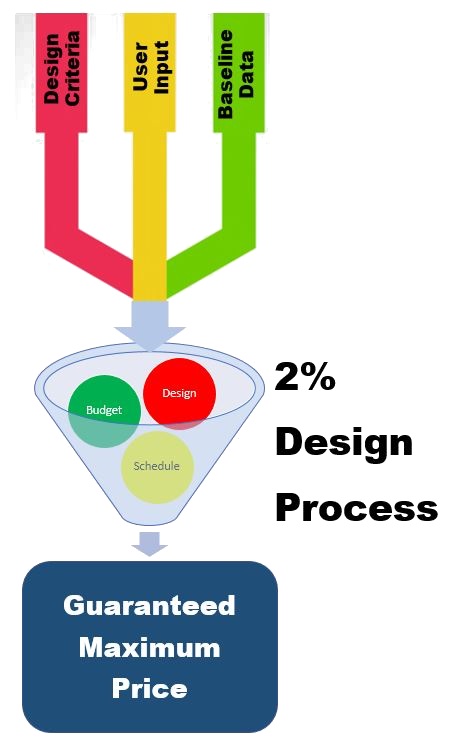
The issue of wringing-out unnecessary project costs was perhaps less acute when fast-payback energy efficiency projects were more plentiful. But with white-hot focus from owners now being placed on energy resiliency, microgrids, energy storage, and power quality and reliability, it is imperative that all unnecessary direct costs be squeezed from projects. This can only be effectively accomplished at the trades subcontractor and equipment procurement levels through transparent competitive selection processes. Unfortunately, the type of competition that produces lowest-cost pricing can only be achieved with competent bidding documents and specifications that are clear and unambiguous.
Power Surety provides engineered plans and specifications for projects we are involved with, as early in the development process as possible. We design exclusively in 3-D and typically prepare designs through the schematic design level (35%), which is sufficient to perform material take-offs for engineering estimates. A typical schematic design set will include the following:
1) Outline Equipment Specifications
2) Single-line Electricals
3) Electrical and Mechanical General Arrangements including Major Distribution Runs
4) Preliminary Site Plan
5) Preliminary Demo Plan
6) Equipment Schedules
7) Basis of Design Narrative
8) Control System Block Diagram / Philosophy / Network Map
We strongly believe that this level of design is necessary to provide project stakeholders the right information from which to collaborate on the project and make informed decisions. The combination of the below deliverables is what Power Surety calls a “2% Guaranteed Maximum Price (GMP) Package.”
The “2%” relates to the typical cost for this package as it relates to the total construction price of the project. As an example, a $2.5 million microgrid project would roughly equate to a cost of $50,000 for this level of design information.
The 2% package provides the necessary information to positively understand costs, schedules and project returns; enables an Integrated Project Delivery (IPD) platform to integrate stakeholders into the early development efforts; provides an early-start for lengthy permitting and interconnect processes; and sets up fast-track project development and delivery schedules moving forward.
– Project Initial Development
– IPD Stakeholder Collaboration
– Programming and Concept Design
– ROM Pricing and Feasibility
– Schematic Designs and Specifications
– Sufficient to support quantity takeoffs
– Sufficient to support competitive market pricing
– Prepare bid comparisons (BidComps) for critical systems and equipment
– Early Permitting and Interconnect Activities
– Prepare GMP Engineering, Procurement and Construction (EPC) Costs
– Prepare Operational Proformas
– Based on market pricing, cost estimates and forecasts for the life of the project
In addition to enabling fast and confident decision-making by project stakeholders, PDaaS enables developers and energy service providers to rapidly scale and deploy project teams on-demand and only when needed. By engaging PowerSurety under a PDaaS model, you will be able to react to customer requests more efficiently and with the right competencies to mitigate risk.
PDaaS also allows you to minimize operating expense and preserve headcount requisitions for core positions that may be better utilized across the organization. Human resources are also conserved by avoiding investment in hiring and training new full-time employees who may require more time to get up to speed and then not be fully utilized at the completion of a large project.
Lastly, PowerSurety’s PDaaS structure enables a proactive resourcing model in lieu of a reactive one which can lead to higher operating expenses and lower quality resourcing. To learn more, contact us so that we can discuss your needs and answer questions.



